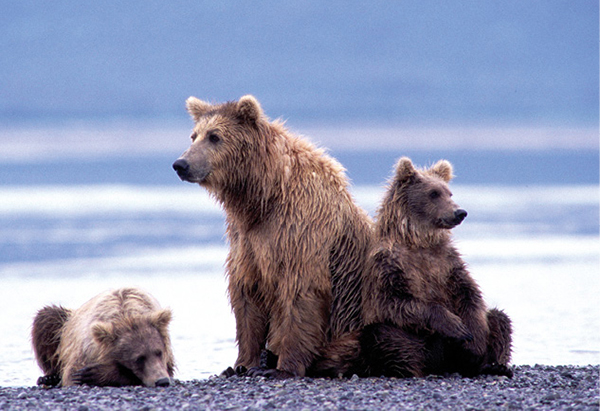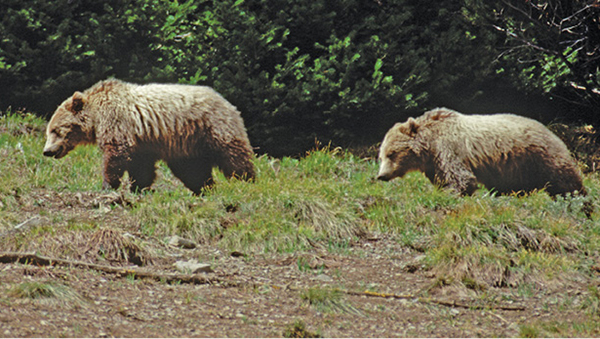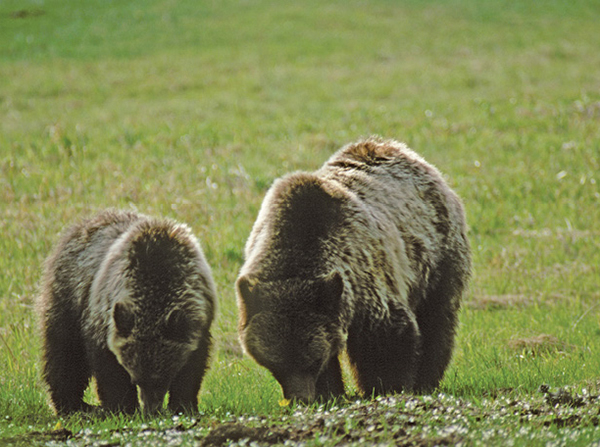
Alaska and western Canada have the highest concentrations of grizzly bears in North America, many of which live in coastal areas. Photo William Mullins
Current Range
Currently, grizzly bears are found in the greatest numbers in Alaska and western Canada. They also range across northern Canada in the Yukon and Northwest Territories and Nunavut. An estimated 30,000 or more grizzly bears inhabit Alaska. Canada’s grizzly bear population is estimated at 26,000 animals, nearly half of which are found in British Columbia.
In the contiguous United States, members of this species are known to inhabit Washington, Idaho, Montana, and Wyoming. Within those four states grizzly bears definitively occupy five ecosystems identified by the USFWS. In Washington State grizzlies inhabit the north-central portion in the North Cascade Mountains. This area is known as the North Cascades recovery zone for grizzly bear management. The area includes remote, mountainous terrain in and around North Cascades National Park. Bears living in this area also inhabit contiguous habitat in southern British Columbia. At the present time the USFWS estimates there are fewer than twenty grizzlies in the portion of this ecosystem that lies within the United States, with perhaps another two dozen bruins in British Columbia. Given the limited number of bears in the area, most biologists feel this remnant population of grizzly bears faces low odds of survival without intense recovery efforts, which could include population augmentation with bears transplanted from other areas.
Given the extremely small population of grizzlies that ranges across the 9,500-square-mile North Cascades recovery zone, efforts to observe and study the bears often meet with failure. However, random encounters with grizzlies in the area attest to their survival. In late October 2009 a hiker snapped a few photos of a grizzly bear he encountered while hiking in the upper reaches of the Cascade River drainage. The photos came to light in the public eye in 2010. At the time, some wildlife officials believed grizzly bears had abandoned the North Cascades portion of the United States. However, given the bear’s location, biologists concluded it wasn’t likely a transient bear from Canada, but a bruin that resided in the United States. Though precarious, the population of grizzly bears in the North Cascades is apparently still viable.

Alaska and western Canada have the highest concentrations of grizzly bears in North America, many of which live in coastal areas. Photo William Mullins
East of the North Cascades, grizzly bears are also found in Washington state in the Selkirk Mountains north of Spokane, a population area that also includes the extreme northern portion of Idaho. This grizzly bear recovery area includes 2,200 square miles, an area just smaller than the state of Delaware. Similar to the North Cascades ecosystem, grizzly bear habitat in the Selkirk Mountains runs northward into Canada.
The Selkirk ecosystem has distinct boundaries. On the north and east sides, Kootenay Lake (British Columbia) and the Kootenai River (Idaho) form natural geographic boundaries. On the south and east sides, the Selkirk ecosystem finds its limits at the Salmo River (British Columbia) and the Pend Oreille River (Washington and Idaho). The Selkirk ecosystem is home to an estimated forty to fifty grizzly bears, based on data published by the USFWS. Human-caused mortality appears to be the greatest inhibitor to growth of this grizzly bear population. Of the grizzly bear deaths recorded in the period from 1983 to 2002, a full 80 percent were human caused. A small percentage of the bears were misidentified by hunters legally hunting black bears. Others were removed by wildlife managers after becoming “problem bears” that strayed into small towns, raided campsites or cabins, or engaged in other activities that threatened humans. A few bears were killed by illegal hunting activities (poaching).
Not far east of the Selkirk Mountains lies a third recovery zone for grizzly bears. Known as the Cabinet-Yaak recovery zone, this area encompasses 2,600 square miles of habitat that lies primarily in northwestern Montana, but also extends westward into the Idaho Panhandle. The Cabinet-Yaak ecosystem is divided into two distinct segments by the Kootenai River in northwestern Montana. The Yaak River segment of this recovery area lies north of the Kootenai River, the Cabinet Mountain portion to the south. The Cabinet Mountain portion of the ecosystem composes roughly 60 percent of the total area and includes the Cabinet Mountain Wilderness. Grizzly bear habitat extends from the Cabinet-Yaak portion of the United States northward into Canada.
The USFWS estimates that thirty to forty grizzly bears inhabit the Cabinet-Yaak recovery zone. Human-caused mortality was lower in the Cabinet-Yaak recovery zone in the 1983 to 2002 time period than in the Selkirk zone, although around 50 percent of the bears in the research study that died were killed as a result of humans. Most of the deaths occurred within a relatively short distance of a road, a trend similarly recorded in the Selkirk recovery zone. This factor points to a key principle in maintaining grizzly bear habitat. The bears do best in areas where they’re buffered from frequent encounters with people and the trappings of human civilization.

Misidentification by humans hunting black bears accounts for grizzly bear deaths in Montana and other states. Subadult grizzlies (like these two) are most often mistakenly targeted by hunters.
Moving eastward into northern Montana, the Northern Continental Divide recovery area includes Glacier National Park, the Bob Marshall Wilderness Complex, and adjacent areas. Grizzly habitat associated with this ecosystem (also known as the NCDE) extends northward into Canada. This area is home to one of the largest populations of grizzly bears in the contiguous United States. A five-year study completed in 2008 using DNA samples from hair-snagging stations and bear rubs in the NCDE revealed samples from 563 individual bears. Undertaken by a team of over 200 researchers and assistants from the Northern Divide Grizzly Bear Project, statistical analysis of the data to account for bears not sampled in the project indicates that slightly more than 750 bears roamed the NCDE at the close of the study. The population has been increasing, with bears moving from the recovery zone into adjacent areas. Similar to other parts of the country, grizzly conflicts and mortality are highest in the NCDE where bears routinely come into contact with humans. Less than 20 percent of the land area in this recovery zone is owned by private entities. However, private land accounts for the highest percentage of human-bear conflicts and bear deaths.
The most well-known population of grizzly bears in the contiguous United States ranges across an area encompassing Yellowstone National Park and adjacent wildlands. Known as the Greater Yellowstone Ecosystem, this region includes several wilderness areas in addition to Yellowstone National Park. Grizzly bears in this area are also found in Grand Teton National Park in Wyoming. Bears are found as far east as the northwestern portion of the Wind River Indian Reservation in Wyoming and westward along the Montana-Idaho divide to a point roughly 50 miles west of Yellowstone National Park. The bears have expanded their range from a core area around Yellowstone to the Bridger-Teton National Forest south of Grand Teton National Park in Wyoming, the Targhee National Forest on the west side of the Teton Range in Idaho, and the Beaverhead-Deerlodge National Forest west of Yellowstone National Park in Montana.
In 2007 the USFWS declared this growing grizzly population to be recovered, no longer meeting endangered or threatened status as defined by the Endangered Species Act. However, an order issued in 2009 from the federal district court in Missoula, Montana, overturned the delisting of the grizzly bears in the Yellowstone area, returning them to protection under the Endangered Species Act, a status they have carried since 1975. Regardless of the bears’ position under the Endangered Species Act, grizzly bears are doing well in the Yellowstone recovery area. When they were listed as a threatened species in the lower forty-eight states in 1975, an estimated 136 grizzly bears were found in the Yellowstone recovery area. Current population estimates exceed 500 animals. Yearly population increases of grizzly bears in the Yellowstone area have been as high as 7 percent. Biologists from a multi-agency team of researchers have concluded that more than 600 of these great brown bears roam the wildlands in and around Yellowstone National Park. The researchers note that their population estimate is very conservative, making it possible that the number of bears actually living in the area is significantly higher.
When the grizzly bear was listed as a threatened species under the Endangered Species Act, a sixth recovery area was identified, though it was believed to be void of grizzly bears. The Bitterroot recovery zone spans 5,600 square miles of habitat in east-central Idaho and western Montana, including two large wilderness areas: the Selway-Bitterroot Wilderness area on the Idaho-Montana divide (west of Hamilton, Montana) and the Frank Church Wilderness (west of Salmon, Idaho). Preliminary plans to reintroduce grizzly bears into the Bitterroot recovery area were eventually abandoned by the USFWS. Although the USFWS took an official position that bears were absent from the ecosystem and proposed a reintroduction program in 1997, the reintroduction plan was withdrawn as a proposal in 2001. Opposition to the reintroduction plan came on several fronts. Some local residents opposed having grizzly bears in the area under any plan. Others believed that grizzly bears did inhabit the area and were concerned that a reintroduced population would not be afforded the same federal protections as native bears. Grizzly bears are evidently taking matters into their own hands. A black bear hunter accidentally shot a young male grizzly in September 2007 while hunting in the northern end of the Bitterroot recovery zone. Since then several other grizzly bear encounters have clearly established that bears are present in or very near the recovery zone. Many of these animals have been young males, a segment of the population much more likely to wander than older males or breeding-age females. However, many experts now believe grizzly bears will recolonize this expanse of rugged habitat on their own.

The area in and around Yellowstone National Park harbors the highest number of grizzly bears in the lower forty-eight states. Yellowstone’s grizzly bear population has been growing in recent years due to good cub production and survival.